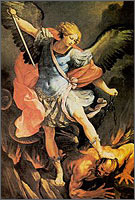 There is a church in Rome called Sta Maria della Concezione (located at Via Vittorio Veneto 27) which has a crypt with five vaulted rooms containing the bones and graves of over 4000 Capuchin Franciscans, assembled in a unique ornamental fashion in 1764. All decorations in the white-painted rooms are made of human bones. From the light fixtures to the crucifixes to the angels--all ornamentation reminds the viewer that human life is ephemeral.
There is a church in Rome called Sta Maria della Concezione (located at Via Vittorio Veneto 27) which has a crypt with five vaulted rooms containing the bones and graves of over 4000 Capuchin Franciscans, assembled in a unique ornamental fashion in 1764. All decorations in the white-painted rooms are made of human bones. From the light fixtures to the crucifixes to the angels--all ornamentation reminds the viewer that human life is ephemeral.
I visited the church once in 1999, then returned again in the company of my wife in 2003. She loved it. But then, she has a streak of the macabre. One thing she noticed is that death and life co-exist in a rough and ready way in Italy. There is no attempt to keep death out of sight. And so, wherever you look--whether inside the churches or in the village squares--you will find symbols and tokens of death along side those of life. Something about this strikes me as healthy and good; just as something about the American treatment of death as a kind of obscenity strikes me as perverted and dysfunctional. An old Catholic motto is: momento mori ("remember death")! Even the noble pagan, Socrates, considered the task of philosophy a preparation for death. What could be more important, he asked, than the care of the soul?
The final room of the quiet journey through the Capuchin Crypt at Sta Maria della Concezione contains these words from beyond:
"What you are now we used to be; what we are now you soon will be."It is a dislocating yet moving sentiment to the tourist, who may have just toddled across the street from Rome's Hard Rock Cafe unknowingly entering this world of memento mori.
 The crypt is open every day but Thursday, from 9 to noon and 3 to 6. There is no admission fee, but you are asked to donate what you can. No photography is allowed. A small gift store at the front sells post cards of each of the rooms. (For reproduction of two post cards with photos by Cristafaro Guiseppe, visit IgoUgo website here.)
The crypt is open every day but Thursday, from 9 to noon and 3 to 6. There is no admission fee, but you are asked to donate what you can. No photography is allowed. A small gift store at the front sells post cards of each of the rooms. (For reproduction of two post cards with photos by Cristafaro Guiseppe, visit IgoUgo website here.)
Sta Maria della Concezione also houses the famous painting by Guido Reni of St. Michael the Archangel trampeling Satan (above right).

No comments:
Post a Comment